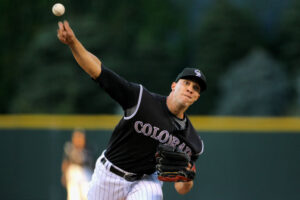Understanding Elbow Pain – Part 3: Pitching Injuries
In case you missed them, check out Part 1 (Functional Anatomy) and Part 2 (Pathology) of this series from last week. With that housekeeping out of the way, let’s move forward to today’s focus: elbow injuries in throwing athletes. I work with a ton of baseball players and I know we have a lot of not only players, but parents of up-and-coming baseball stars that read this blog – so it’s a topic that is near and dear to my heart. While my primary focus within the paragraphs that follow will be baseball, keep in mind that the many these issues can also be seen in other overhead athletes. They just tend to be more prevalent and magnified in a baseball population.
Obviously, in dealing with loads of baseball guys, I see a lot of elbow issues come through my door. The overwhelming majority of those folks are medial elbow pain, but we also see a fair amount of lateral elbow pain. What’s interesting, though, is that in a baseball population, most of these issues are purely mechanical pain; that is, the discomfort is usually only present with throwing, as it is tough to reproduce the velocities and joint positions present during overhead (or sidearm/submarine) throwing.
The question, logically, is why do some throwers break down medially while others break down laterally, or even posteriorly?
In other to understand why, we first have to appreciate the demands of throwing. And, that appreciation pretty much always leads back to the valgus and extension forces (termed valgus-extension overload by many) that combine to wreak havoc on an elbow during throwing.
At late cocking – where maximal external rotation (or “lay-back”) occurs – there is a tremendous valgus force of 64Nm on the elbow, according to Fleisig et al.
As Morrey et al. determined, the ulnar collateral ligament (UCL) “takes on” approximately 54% of this valgus force – meaning that it’s assuming about 35Nm of force on each pitch. This is all well and good – until you realize that in cadaveric models, the UCL fails at 32Nm.

If the valgus forces are so crazy that they actually exceed the UCL’s tolerance for loading, why don’t we just rip that sucker to shreds on every pitch?
It’s because the UCL doesn’t work alone. Rather, we’ve got soft tissue structures (namely, the flexor carpi ulnaris and radialis) that can protect it. This is why cadavers don’t usually pitch in the big leagues. The closest thing I’ve seen is 84-pound Willie McGee, but he was an outfielder.
Keep in mind that it isn’t just the UCL that’s stressed in this lay-back position. Obviously, the flexor-pronator mass takes a ton of abuse in transitioning from cocking to acceleration. It’s also a tremendously vulnerable position for the ulnar nerve as it tracks through some tricky territory. That just speaks to the medial side of things; there is more to consider laterally.
You see, the same valgus force that can wreak havoc medially also applies approximately 500N on the radioulnar joint during the late cocking phase of throwing; that’s about one-third of the total stress on the elbow. In this case, a picture is worth a thousand words:
So, the same forces can cause a thrower to break down in multiple areas both medially and laterally! What usually separate the medial from the lateral folks?
Let me ask you this: when was the last time you saw an 8-year old rupture his ACL? Never.
Now, when was the last time you saw an 8-year-old break a bone? Happens all the time.
This same line of reasoning can be applied to the pitching elbow. The path of least resistance – or the area of incomplete development – will generally break down first. As such, in a younger population, we generally see more lateral, compression-type injuries to the bones. These are your growth plate issues and Little League Elbows, usually.
As athletes mature and the bones become sturdier, we get more muscle/tendon, ligament, and nerve issues on the medial side.
This isn’t always the case, of course; you’ll see young kids with medial elbow pain, and experienced throwers with lateral issues as well. It generally holds pretty true, though.
The issues at the cocking-to-acceleration transition would be bad enough by themselves, but there is actually another important injury mechanism to consider: elbow extension.

This lateral area also takes on about 800N of force at the moment arm deceleration begins with elbow extended out in front as posteromedial impingement occurs between the ulna and the olecranon fossa of the humerus. This bone-on-bone contact at high velocities (greater than 2,000 degrees/second) can lead to fractures and loose bodies within the joint.
This wraps up the causative factors with respect to elbow pain in throwers – but I need to now go into further detail on the specific physical preparation and mechanical factors one needs to consider to avoid allowing these issues to come to fruition. Stay tuned for Part 4.
Please enter your email below to sign up for our FREE newsletter and receive a FREE deadlift technique tutorial.







